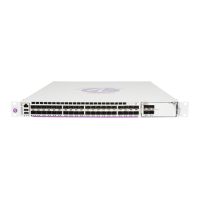Event and Accounting Logs
7705 SAR OS System Management Guide Page 209
Simple Logger Event Throttling
Simple event throttling provides a mechanism to protect event receivers from being
overloaded when a scenario causes many events to be generated in a very short period of
time. A throttling rate (events/seconds), can be configured. Specific application events can
be configured to be throttled. Once the throttling event limit is exceeded in a throttling
interval, any further events of that type are dropped and the dropped events counter is
incremented. Dropped events counts are displayed with the show>log>event-control
command. Events are dropped before being sent to one of the logger event collector tasks.
There is no record of the details of the dropped events and therefore no way to retrieve event
history data lost by this throttling method.
A particular event type can be generated by multiple managed objects within the system. At
the point that this throttling method is applied, the logger application has no information
about the managed object that generated the event and cannot distinguish between events
generated by object "A" from events generated by object "B". If the events have the same
event-id, they are throttled regardless of the managed object that generated them. The logger
application also cannot distinguish between events that will be logged to destination log-id
<n> from events that will be logged to destination log-id <m>.
Throttle rate applies commonly to all event types. It is not configurable for a specific event
type.
A timer task checks for events dropped by throttling when the throttle interval expires. If any
events have been dropped, a TIMETRA-SYSTEM-MIB::tmnxTrapDropped notification is
sent.
By default, event throttling is set to off for each specific event type. It must be explicitly
enabled for each event type where throttling is desired. This makes backwards compatibility
of configuration files easier to manage.

